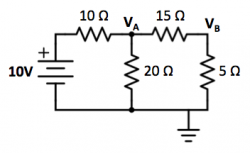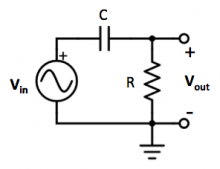Assignment 6, Part 1: Pre-lab questions
This is Part 1 of Assignment 6.
Problems
| |
your answers to the following questions |
Question 1
Consider the following circuit composed of a network of resistors:
a) Combining resistance values in parallel and in series, draw a simplified version of the circuit containing the given voltage source (10V) and one equivalent resistor. Label the equivalent resistance value.
b) Find the voltage values for the nodes $ V_A $ and $ V_B $ in the above diagram.
Question 2
Referring to the circuit shown below, what value of $ R_L $ (in terms of $ R_1 $ and $ R_2 $) will result in the maximum power being dissipated in the load?
Hint: this is much easier to do if you first remove the load, and calculate the equivalent Thevenin output resistance $ R_T $ of the divider looking into the node labeled $ V_{out} $. Then express $ R_L $ for maximal power transfer in terms of $ R_T $.
Question 3
In the following circuit, R = 10 kΩ and C = 10 nF.
a) Find the transfer function $ {V_{out} \over V_{in}} $.
b) What type of filter is this? Justify your answer.
c) What is the cutoff frequency of this filter? Write your answer in units of Hz. Remember that $ \omega = 2 \pi f $.
Note: You may find the pages on Impedance Analysis and Transfer Functions and Bode Plots helpful for this problem.



